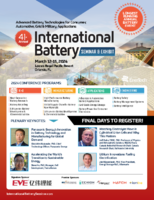2024年 教学*
2024年3月12日(二) 8:30 - 10:00 am
TUT1: Sodium-ion Batteries
Na-ion Batteries: Materials and State-of-the-Art
Philipp Adelhelm, PhD, Professor, Institute of Chemistry, Humboldt-University Berlin
Na-ion batteries (SIB) are rapidly developing as potential alternatives to complement Li-ion battery (LIB) technology. The energy densities of SIB are close to LIB, but at the same time they avoid or reduce the amounts of many critical elements used for LIB. Due to their conceptual similarity, SIB can be produced on the same manufacturing lines as LIB, which is a great advantage for market implementation. This tutorial gives an overview on Na-ion battery development, with the focus on materials (anode, cathode) and electrolytes.
INSTRUCTOR BIOGRAPHIES:
 Philipp Adelhelm, PhD, Professor, Institute of Chemistry, Humboldt-University Berlin
Philipp Adelhelm, PhD, Professor, Institute of Chemistry, Humboldt-University Berlin
TUT2: Battery Safety & Abuse Tolerance Validation
Battery Safety and Abuse Tolerance Validation
Shmuel De-Leon, CEO, Shmuel De-Leon Energy Ltd.
Batteries have become daily use components for many applications. New growing segments like EV and grid storage batteries extend the traditional ordinary battery applications. In the race for energy density, we shouldn't forget safety. For example, the Samsung Galaxy Note 7 battery safety case. Unfortunately, we face daily safety events with injuries and severe damage. This workshop focuses on portable, stationary, and automotive battery safety along the battery cycle life (acceptance, testing, assembly, use, transportation, and disposal). This training incorporates Shmuel De-Leon’s and other experiences on battery safety, representing over 26 years of work in the field. The motivation behind the training is to provide attendees with the knowledge needed to safely handle the batteries in their organization, and to support reduction in safety events.
INSTRUCTOR BIOGRAPHIES:
 Shmuel De-Leon, CEO, Shmuel De-Leon Energy Ltd.
Shmuel De-Leon, CEO, Shmuel De-Leon Energy Ltd.
TUT3: Technoeconomic Analysis
Technoeconomic Analysis: Effective Development and Commercialization Pathways for New Battery Technologies
Thomas D. Gregory, Owner and Consultant, Borealis Technology Solutions LLC
Technoeconomic analysis is often thought to be synonymous with cost estimation, but it is also a powerful tool for guiding process and product R&D as well as assessing competing technology. This tutorial will illustrate the value of integrating technoeconomic analysis into new product and process development from laboratory to plant construction, focusing on the early stages of development when critical decisions such as process route selection must be made with limited data. Techniques for estimating capital and operating costs will be covered, ranging from simple analogies to more complex methodologies. Using the results to differentiate between process options and proceed from “What can we do?” to “What should we do?” will be highlighted. These concepts and methodologies will be illustrated with real-world examples based on the instructor’s 40+ years of industrial experience.
TOPICS TO BE COVERED:
- Factors that impact successful commercialization of battery materials
- Technological feasibility versus economic practicality-market need/company capability intersection
- Technoeconomic analysis methodology, focusing on the critical early stages of a project where product design and process chemistry and development occur amid significant technical and economic uncertainty
INSTRUCTOR BIOGRAPHIES:
 Thomas D. Gregory, Owner and Consultant, Borealis Technology Solutions LLC
Thomas D. Gregory, Owner and Consultant, Borealis Technology Solutions LLC
TUT4: In-Depth Analysis of the Chinese xEV Battery Industry
In-Depth Analysis of the Chinese xEV Battery Industry-From Applications to Upstream Materials
Mark H. L. Lu, PhD, Senior Industrial Analyst, Industrial Economics & Knowledge Center, Industrial Technology Research Institute
As the world’s biggest EDV market, Chinese xEV industry has become the most important pioneering target. However, specially planned economy, localized regulations, and multiple business models exist and make international companies’ decision-making more difficult. Therefore, this tutorial will try to provide a whole picture of the Chinese EDV battery market including policies & regulations, future forecasts, competitive analysis, battery technology strategies, upstream supply chain, and positioning for foreign enterprises.
INSTRUCTOR BIOGRAPHIES:
 Mark H. L. Lu, PhD, Senior Industrial Analyst, Industrial Economics & Knowledge Center, Industrial Technology Research Institute
Mark H. L. Lu, PhD, Senior Industrial Analyst, Industrial Economics & Knowledge Center, Industrial Technology Research Institute
2024年3月12日(二) 10:30 - 12:00 pm
TUT5: Solid-State Batteries
Solid-State Batteries
Venkataraman Thangadurai, PhD, Professor, Chemistry, University of Calgary
In this tutorial lecture, the development of state-of-the-art solid-state Li-ion and Na-ion electrolytes for all-solid-state batteries with emphasis on ionic conductivity and chemical and electrochemical stabilities will be discussed.
INSTRUCTOR BIOGRAPHIES:
 Venkataraman Thangadurai, PhD, Professor, Chemistry, University of Calgary
Venkataraman Thangadurai, PhD, Professor, Chemistry, University of Calgary
TUT6: Technical Approaches to Li-ion Battery Recycling
Technical Approaches to Li-ion Battery Recycling
Eric Gratz, PhD, Co-Founder & CTO, Ascend Elements
The tutorial will detail how spent batteries are transformed into new materials and reintroduced into the battery supply chain. The tutorial will overview both pyro and hydrometallurgical processes, as well as new innovations in recycling and sustainable battery materials engineering.
INSTRUCTOR BIOGRAPHIES:
 Eric Gratz, PhD, Co-Founder & CTO, Ascend Elements
Eric Gratz, PhD, Co-Founder & CTO, Ascend Elements
TUT7: Accelerating EV Battery Design through Simulation
Accelerating EV Battery Design through Simulation
Vidyu Challa, PhD, Reliability Manager, ANSYS, Inc.
INSTRUCTOR BIOGRAPHIES:
 Vidyu Challa, PhD, Reliability Manager, ANSYS, Inc.
Vidyu Challa, PhD, Reliability Manager, ANSYS, Inc.
TUT8: Cell and Pack Design
Cell & Pack Deisgn
Kevin Konecky, Battery and Energy Storage Systems Consultant, Total Battery Consulting
This tutorial will give an overview of battery systems design. An overall product development process will be discussed for a typical system. Design aspects of each individual subsystem will be explored with cost impacts of different design choices. Testing, validation, and designing for safety will be other key areas of discussion.
INSTRUCTOR BIOGRAPHIES:
 Kevin Konecky, Battery and Energy Storage Systems Consultant, Total Battery Consulting
Kevin Konecky, Battery and Energy Storage Systems Consultant, Total Battery Consulting
2024年3月12日(二) 1:30 - 3:00 pm
TUT9: Improving the Energy Density of Batteries with Silicon-Based Anodes
Improving the Energy Density of Batteries with Silicon-Based Anodes
Dee Strand, PhD, CSO, R&D, Wildcat Discovery Technologies, Inc.
The key challenges in the use of silicon-based anodes, as well as progress in the implementation of silicon and what can we expect in the future. The latest improvements in other battery components are required to maximize the benefit of silicon-based anodes.
INSTRUCTOR BIOGRAPHIES:
 Dee Strand, PhD, CSO, R&D, Wildcat Discovery Technologies, Inc.
Dee Strand, PhD, CSO, R&D, Wildcat Discovery Technologies, Inc.
TUT10: Latest Developments on the Safe Transport and Storage of Lithium Batteries
Latest Developments on the Safe Transport and Storage of Lithium Batteries
George A. Kerchner, Executive Director, PRBA Rechargeable Battery Association
There have been substantive changes to the lithium battery transport regulations, fire codes, and building codes that will impact every company involved with shipping, transporting, and storing of new and used lithium batteries in the United States. This tutorial will address all these changes and provide practical solutions for complying with these new regulatory requirements.
INSTRUCTOR BIOGRAPHIES:
 George A. Kerchner, Executive Director, PRBA Rechargeable Battery Association
George A. Kerchner, Executive Director, PRBA Rechargeable Battery Association
TUT11: Li-ion Battery Safety & Thermal Runaway
Li-ion Battery Safety & Thermal Runaway
Ahmad A. Pesaran, PhD, Chief Energy Storage Engineer, National Renewable Energy Laboratory
Application of lithium-ion batteries (LIB) in electrified transportation and renewable grid is growing at a very fast pace for decarbonization of the passenger vehicles by 2035. Due to the characteristics of current LIB technologies, although rare, there is potential for thermal runaway and fires, as seen by recent fires in Tesla Model S, Chevy Bolt, and grid storage system in an Arizona Utility. Increased severity of fire incidents with more advanced energy-dense LIBs, especially cathodes with higher Ni, and anodes with silicon or lithium, is expected.
In this tutorial/seminar we will: 1.) discuss fundamental causes for safety issues leading to thermal runway and fire, 2.) review abusive behavior of cells and packs through characterization, testing, and modeling/simulations, 3.) provide overview of approaches that could reduce safety risks and detect impending failures, and 4.) provide references as a resource for accessing more information.
This tutorial/seminar is provided by Dr. Ahmad Pesaran with 25+ years’ experience in lithium-ion battery R&D including safety testing and modeling with perspectives of his participation at USABC Technical Advisory Committee. He will provide the audience with information and understanding needed to handle Li-ion battery safety in both their work at their companies and in products they deliver to the market.
TOPICS TO BE COVERED:
- LIB Applications LIB Introduction
a. Battery Fundamentals
b. Battery Chemistries
c. Cell Designs - LIB Safety and Abuse
a. LIB Fires
b. Instigators for Thermal Runaway
c. Battery Abuse Characterization and Testing Equipment
d. Battery Abuse Modeling/Simulation Tools - Approaches for Designing Safer Cells and Modules-Recent Progress of EV Pack and System Safety
- Remarks on Safe Handling of LIBs Summary
INSTRUCTOR BIOGRAPHIES:
 Ahmad A. Pesaran, PhD, Chief Energy Storage Engineer, National Renewable Energy Laboratory
Ahmad A. Pesaran, PhD, Chief Energy Storage Engineer, National Renewable Energy Laboratory
TUT12: The Rechargeable Battery Market: Value Chain & Main Trends
The Rechargeable Battery Market: Value Chain and Main Trends, 2023-2033
Christophe Pillot, PhD, Director, Avicenne Energy
ABOUT THIS TUTORIAL:
This tutorial will present the 10-year automotive market forecasts from Avicenne and other analysts (micro/Hybrid/P-HEV/EV). Other coverage will include car makers’ strategies and advanced energy storage (advanced lead acid/supercap/NiMH/LIB). Additionally, LIB design for P-HEV & EV markets (cylindrical, prismatic, pouch/wounded, stacked, Z fold cells) and LIB cell, module, and pack cost structure will be discussed.
TOPICS TO BE COVERED:
- The rechargeable battery market in 2023
- Battery market by application
- Electronic devices, xEV, e-bikes, power tools
- Stationary applications
- Raw material for lithium-ion battery supply chain
- Battery market forecasts, 2023-2033
- Focus on xEV market
- OEM supply chainx
- EV forecasts
- Impact of Li-ion batteries on lead acid battery market
- Conclusions
INSTRUCTOR BIOGRAPHIES:
 Christophe Pillot, PhD, Director, Avicenne Energy
Christophe Pillot, PhD, Director, Avicenne Energy
2024年3月12日(二) 3:15 - 4:45 pm
TUT13: Safety, Reliability & Performance for Energy Storage Projects
Key Factors for Successful Implementation and Utilization of Battery Energy Storage Systems
Matthias Vetter, PhD, Department Head, Electrical Energy Storage, Fraunhofer Institute for Solar Energy Systems ISE
Battery energy storage systems are the backbone for efficient and reliable use of fluctuating, renewable energy sources in power grids. They can be used in behind-the-meter energy supply systems as well as in utility-scale applications. For successful projects, risks on a technical and economical level have to be considered and are addressed by quality-assurance measures, which have to include the following topics:
- Safety on a component and system level including functional safety
- Reliability on a component and system level
- Performance: efficiency and effectiveness
Aging of battery cells has a strong impact on these key factors. Therefore, verification and evaluation have to consider not only system behavior at beginning of life but also at an aged status. In this context, it is important to investigate the application-specific degradation rate and not only equivalent full cycles and calendric lifetime.
INSTRUCTOR BIOGRAPHIES:
 Matthias Vetter, PhD, Department Head, Electrical Energy Storage, Fraunhofer Institute for Solar Energy Systems ISE
Matthias Vetter, PhD, Department Head, Electrical Energy Storage, Fraunhofer Institute for Solar Energy Systems ISE
TUT14: Li-ion Cell Design for Manufacturing
Li-ion Cell Design and Manufacturing: Processes, Equipment, and Quality Control
James Kaschmitter, CEO, SpectraPower LLC
This tutorial will begin with an overview of Li-ion cell design for performance and manufacturability, including contrasting the performance and characteristics of commonly used materials. The tutorial will then lead to a detailed review of Li-ion cell manufacturing, from incoming raw materials through final cell formation, aging, and shipment.
INSTRUCTOR BIOGRAPHIES:
 James Kaschmitter, CEO, SpectraPower LLC
James Kaschmitter, CEO, SpectraPower LLC
TUT15: Cell Passport-Designing Li-ion Rechargeable Cell Data Sheets
Cell Passport-Designing Optimal Lithium Rechargeable Cell Data Sheets
Shmuel De-Leon, CEO, Shmuel De-Leon Energy Ltd.
Cell data sheets provided by battery manufacturers describe cell functions, performance, operational limits and safety prohibitions. Device manufacturers rely on data sheets for cell selection and battery pack design. These data sheets provide critical information on function, performance and safety. It is also used for marketing purposes. We have prepared an optimal cell data sheet template for rechargeable lithium cells based on review of our extensive collection of data sheets. This tutorial will focus on how to prepare and read an optimal lithium rechargeable data sheet and how to define and test each parameter.
INSTRUCTOR BIOGRAPHIES:
 Shmuel De-Leon, CEO, Shmuel De-Leon Energy Ltd.
Shmuel De-Leon, CEO, Shmuel De-Leon Energy Ltd.
TUT16: Battery Sustainability
Sustainability in the Automotive Battery Supply Chain
Stefan Debruyne, Director, Business Development, Lithium, SQM International
Considering the increasing interest in supply chain due diligence related to initiatives, such as the US Inflation Reduction Act and the EU Battery Regulation, the ESG aspect of raw material production is becoming more and more important. However, the ESG landscape is one that merges several highly specialist fields, which can be tremendously confusing to the many stakeholders of the automotive battery value chain. The objective of the tutorial is to provide participants with an understandable overview of some of the latest and key aspects of sustainability initiatives in the automotive battery value chain. What is the best mining assurance standard? What about life-cycle assessment? How do companies work to improve footprints? What is the potential for improvement going forward?
INSTRUCTOR BIOGRAPHIES:
 Stefan Debruyne, Director, Business Development, Lithium, SQM International
Stefan Debruyne, Director, Business Development, Lithium, SQM International
* All Access Registration or separate registration required for Tutorials
* 活动内容有可能不事先告知作更动及调整。














 Next-Generation Battery Research
Next-Generation Battery Research
 High-Performance Battery Manufacturing
High-Performance Battery Manufacturing
 Advances in Automotive Battery Applications
Advances in Automotive Battery Applications
 Battery Safety
Battery Safety